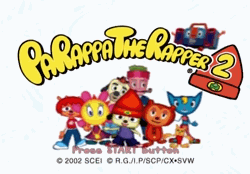 So what’s wrong with failure?
So what’s wrong with failure?
PaRappa the Rapper is a phenomenon that is hard to explain to modern audiences. Look, it was like this: for a long, long time, videogames were just beeps and boops and graphics that were blocky as hell. Or, perhaps, it was just a matter of, for many “gamers” of the time, this had been all anyone had ever known, and that “ever” was our entire childhoods. Studies have been performed that have proven, without a doubt, that, when someone is a child, a year lasts approximately eleventy billion millennia. Meanwhile, when you’re older, a single weekend lasts roughly as long as one cheese sandwich. This created the lopsided imagining that videogames would always be no better than what could be pumped out by an NES or Sega Genesis, and the concept of a theme song or graphics that existed in three dimensions was little more than a pipedream (the old videogames did have a lot of pipes, incidentally). This meant that when PaRappa the Rapper was released stateside in the fall of 1997, players went unexpectedly nuts. In 1997, in one game, you had a CD that featured what many hailed as the culmination of an entire franchise, another disc (or four) showcasing the future of the JRPG genre and what was possible for storytelling, and, finally, here was this weird little rap game that went in another, amazing third direction. The graphics were distinct, bright, and colorful. It had voice acting for every scene, level, and character (in English!). The gameplay was wholly new, or, at the very least, it felt new. Rhythmic button pressing wasn’t new by any means, but this didn’t feel like FMV nonsense or some earlier attempt at guitar heroing. PaRappa was an unexpected feast for the eyes, ears, and thumbs.
Of course, nowadays, everything that made PaRappa unique is completely mundane, and it has been for nearly twenty years. If you’re still excited by voice acting in 2020, you were either just beamed here from the distant part, or you finally figured out how to crank your hearing aid. Or maybe you’re just excited a fighting game finally earned an English dub…
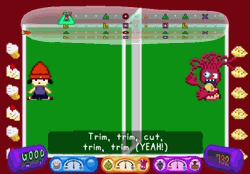 But PaRappa was an unexpected success in 1997, and that inevitably meant it was time for sequels. And that’s great! Because the original PaRappa the Rapper sucked. Yes, the characters were memorable. Yes, it was charming as all get out. And, yes, the nonviolent setting that managed to tell a compelling story was and still is a breath of fresh air. But have you ever actually played PaRappa the Rapper on the original hardware? Practically constructing the entire rhythm genre from raw materials comes with its own share of problems, as so much that we take for granted today is nonexistent in this maiden voyage. Button prompts sometimes appear microseconds before they’re relevant. “Hit detection” is scattershot, and it’s difficult to know exactly why “U Rappin’ Awful”. And, for reasons that no one has ever understood, the instant feedback of a congratulatory tone when you do something right (or perhaps a punishing buzz when something is performed incorrectly) is replaced with… farts. Seriously! I can’t figure out a way to describe these noises in any other way. I’m trying to press triangle at the right time, failing, and the only indicator as to what might be going wrong is some dude slightly off-screen taking his shirt off and going to town with the armpit noises. It’s not helpful, Musical Mike!
But PaRappa was an unexpected success in 1997, and that inevitably meant it was time for sequels. And that’s great! Because the original PaRappa the Rapper sucked. Yes, the characters were memorable. Yes, it was charming as all get out. And, yes, the nonviolent setting that managed to tell a compelling story was and still is a breath of fresh air. But have you ever actually played PaRappa the Rapper on the original hardware? Practically constructing the entire rhythm genre from raw materials comes with its own share of problems, as so much that we take for granted today is nonexistent in this maiden voyage. Button prompts sometimes appear microseconds before they’re relevant. “Hit detection” is scattershot, and it’s difficult to know exactly why “U Rappin’ Awful”. And, for reasons that no one has ever understood, the instant feedback of a congratulatory tone when you do something right (or perhaps a punishing buzz when something is performed incorrectly) is replaced with… farts. Seriously! I can’t figure out a way to describe these noises in any other way. I’m trying to press triangle at the right time, failing, and the only indicator as to what might be going wrong is some dude slightly off-screen taking his shirt off and going to town with the armpit noises. It’s not helpful, Musical Mike!
So, yes, from a gameplay perspective, PaRappa the Rapper had some significant issues. It was very easy to lose, and, given you had to repeat the entire stage after every bomb, every loss grew more and more frustrating. Was this by design? Was the game “artificially padded” to prevent immediate progress so as to obfuscate the fact that there are a total of six short stages? If you know what you’re doing, you can complete PaRappa in less time than it takes to watch a television show (granted, this is true when speedrunning most games of the era, but this is without even trying). Was the advanced difficulty meant to extend the length of the game? 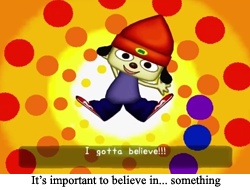 Or was the lack of relevant feedback meant to simulate learning a “freeform” skill like rap? It’s not just about pressing buttons at the right time, player, there’s a je ne sais quoi that cannot be captured by a simple tutorial or… anything but a fart noise. PaRappa the Rapper is exasperating, yes, but it may be for a reason. And if it isn’t for a reason, then they’ll fix it in the inevitable sequel. … Right?
Or was the lack of relevant feedback meant to simulate learning a “freeform” skill like rap? It’s not just about pressing buttons at the right time, player, there’s a je ne sais quoi that cannot be captured by a simple tutorial or… anything but a fart noise. PaRappa the Rapper is exasperating, yes, but it may be for a reason. And if it isn’t for a reason, then they’ll fix it in the inevitable sequel. … Right?
PaRappa the Rapper 2 certainly went in… some kind of direction.
On the surface, this is the same game, just a generation of hardware later. PtR2 is an adventure starring PaRappa where, in an effort to see a dog get deflowered by a flower, you must guide PaRappa through a series of rap battles wherein he gains confidence and the ability to buy a hamburger. All of the raps are new, there are a few more levels on top of the original count, and everything looks and sounds better than it did on the old hardware. There are even escalating, clearly labeled difficulty levels to add a little more replay value to the experience. PaRappa the Rapper 2 did everything PaRappa the Rapper 1 did, but better (give or take your subjective feelings on whether or not a moose driving instructor is better than a moose drill sergeant). But was it easier? Did the directors make more of an effort to help the player through a rap or two? Well, PtR2 did at least give us this guy…
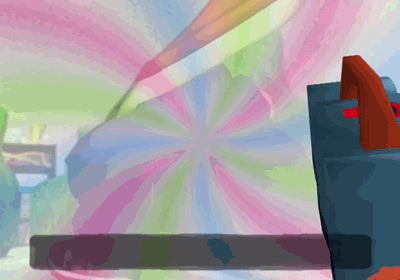
Come on, PaRappa, relax, it’s time to address this weirdo from your second game.
That’s Boxxy Boy, and he appears at the start of every level. It is his purpose to provide a “simple”, beat-heavy version of samplings of the song, so you’re granted an opportunity to practice before starting a level. You cannot fail Boxxy’s training sessions, and you are welcome to test out your phat beats in an environment where you either pass or keep trying (and are never told you’re being awful). It is a safe space, and, frankly, it’s a great concept for inclusion in a rhythm game. The Hatsune Miku games of today (and games based off the same basic concept) have major problems with starting a featured song with 40 required inputs before you even have a moment to figure out the BPM, so a little “here is what this is like” is welcome. Nobody likes to see a game over five seconds after the “level” starts!
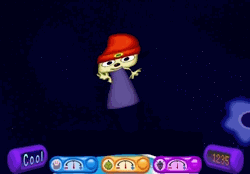 But… would that be so bad? Obviously, it sucked whenever you failed a level in PaRappa the Rapper 1, but, nine times out of ten, that wasn’t because of errors in the opening seconds. It takes time to get to a complicated bridge! And what was the punishment for failure in PtR1? Nothing. You had to repeat the level, but you didn’t have to repeat every previous level, or insert a quarter, or search all over for your missing turtle friends (I’m probably thinking of something specific). Failing sucks, but you’re always a quick restart away from trying again. PaRappa the Rapper 2 is no different, and its additional emphasis on scoring and replays means that there are even greater reasons to ignore any botches that would happen without the omnipresent training tutorial. What’s bad about failing except knowing that you failed?
But… would that be so bad? Obviously, it sucked whenever you failed a level in PaRappa the Rapper 1, but, nine times out of ten, that wasn’t because of errors in the opening seconds. It takes time to get to a complicated bridge! And what was the punishment for failure in PtR1? Nothing. You had to repeat the level, but you didn’t have to repeat every previous level, or insert a quarter, or search all over for your missing turtle friends (I’m probably thinking of something specific). Failing sucks, but you’re always a quick restart away from trying again. PaRappa the Rapper 2 is no different, and its additional emphasis on scoring and replays means that there are even greater reasons to ignore any botches that would happen without the omnipresent training tutorial. What’s bad about failing except knowing that you failed?
Or is simply knowing you can suck enough?
According to interviews, Boxxy Boy’s tutorials were implemented because Rodney Greenblat, the man responsible for fashioning PaRappa and his world, was bad at playing Um Jammer Lammy. Thus, Boxxy was implemented to offer a “gentle” tutorial for anyone that was desperate to make it through the “real” game. And that’s a noble goal! Unfortunately, the reality of the situation is that Boxxy only repeats one distinct section of the song, and does not prepare a player for pushing through those final beats. So ol’ Rodney is probably still going to lose, except now he knows there’s an entire, useless “mini stage” attached to his failures. Is this why we haven’t seen any new PaRappa characters since? Rodney is too demoralized by Boxxy?
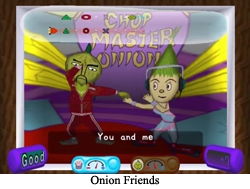 And is that the fear here? That people will give up on PaRappa the Rapper because it is too easy to fail? Is failure so disheartening that people won’t even try? You could claim modern games that revel in try and retry, like Dark Souls and its ilk, disprove this theory. Everyone is chasing that Dark Souls pie right now! But, on the other hand, Souls and the entire “rogue-like” genre is wildly divisive. So much as coughing out the words “Dark Souls” on a forum (they still make those, right?) will lead to a thousand gamers explaining why DS is simultaneously the best and worst thing to ever happen since the Power Glove. And a significant reason for this is that you know there are hundreds of players out there that tried this fancy shmancy new genre, died 70 times, and made up their collective minds to never “waste time” like that ever again. Failure may be upsetting, but squandering your precious time on something that will never lead to success is even worse. Isn’t that why you have a day job? And what is the point of playing a game if you are never going to “beat it”?
And is that the fear here? That people will give up on PaRappa the Rapper because it is too easy to fail? Is failure so disheartening that people won’t even try? You could claim modern games that revel in try and retry, like Dark Souls and its ilk, disprove this theory. Everyone is chasing that Dark Souls pie right now! But, on the other hand, Souls and the entire “rogue-like” genre is wildly divisive. So much as coughing out the words “Dark Souls” on a forum (they still make those, right?) will lead to a thousand gamers explaining why DS is simultaneously the best and worst thing to ever happen since the Power Glove. And a significant reason for this is that you know there are hundreds of players out there that tried this fancy shmancy new genre, died 70 times, and made up their collective minds to never “waste time” like that ever again. Failure may be upsetting, but squandering your precious time on something that will never lead to success is even worse. Isn’t that why you have a day job? And what is the point of playing a game if you are never going to “beat it”?
And maybe that’s why Boxxy works. Failure sucks, and you absolutely cannot fail when practicing with Boxxy. There is no game over, there is no “thou must not pass” (as you can always skip the lil’ dude with the start button), and Boxxy does not judge you. Boxxy is a safe, friendly buddy, and, while you might not beat the next level, at least you can have a little entertainment with this sentient boombox. Is it as much fun as the “real” game? No. But at least no one is going to judge your skills here. Pass? Fail? You’ll be fine just pressing buttons.
There’s nothing wrong with failure, but it is nice to have a place you can avoid failure. Boxxy is here to help.
But he won’t be back again, because PaRappa the Rapper 2 was a failure, and the franchise never returned.
… So maybe it is a good idea to avoid failing.
FGC #537 PaRappa the Rapper 2
- System: Playstation 2 initially, and then Playstation 4. I don’t think there was a PSP/Vita version, but I would not be surprised.
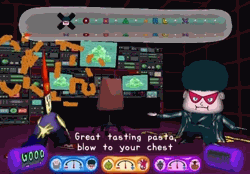 Number of players: Invite over a friend for a rap battle! … I have never subjected anyone I know to this fate.
Number of players: Invite over a friend for a rap battle! … I have never subjected anyone I know to this fate.- Favorite Level: Stage 5: Hair Scare features Um Jammer Lammy and her band, Milk Can. I like Um Jammer Lammy so much more than the little dog in a beanie, so I appreciate that stage. Look, Lammy is just objectively better, as she gets through her entire game without trying to get laid every five seconds, while PaRappa is just a horndog.
- Play it Cool: Every one of the teachers (save the friendly ghost of Stage 1) encourages PaRappa to freestyle until he hits “Cool” ranking. I have never understood what exactly makes PaRappa go Cool, as I have no sense of rhythm, and I only know how to make raps good through excessive rhyming. I’m a writer! Not a musician! … Do you think Boxxy could give me a tutorial?
- What’s in a name: PaRappa Town might sound like one of those lame “the planet is named after the main character” situations (Nobody lives in The World of Lufia, dammit), but “PaRappa” just means “paper-thin” in Japanese, so it’s appropriate for this 2-D environment. Now nobody render anything in 3-D, or it’s all going to fall apart.
- Very Concerning: Beard Burger Master is rapping from beyond the grave in an effort to help PaRappa construct hamburgers. This is a vision of Hell, right?
- Did you know? Rodney Greenblat, the character designer that is responsible for PaRappa’s iconic look,
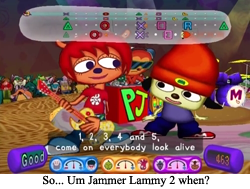 also was responsible for the album art for They Might Be Giant’s self-titled debut album. Put your hand inside the PJ Berri head!
also was responsible for the album art for They Might Be Giant’s self-titled debut album. Put your hand inside the PJ Berri head! - Would I play again: It takes a whole hour to complete PaRappa the Rapper 2, so the fact that it is loaded onto my PS4 means it might see play again. It’s a fun little game, Boxxy invasion or no.
What’s next? Random ROB has chosen… Cadillacs and Dinosaurs! It’s like Jurassic Park! But with cooler cars! Please look forward to it!

[…] that bit in Back to the Future? I guess you guys aren’t ready for that yet), but many point to PaRappa the Rapper as the true origin of what we consider to be rhythm games. And it makes sense! This was one of the […]
[…] sure my favorite “forgotten” genre now is the narrative-based rhythm game (Gitaroo-Man! PaRappa! We need you now more than ever). Typing out this entire paragraph has been doubly amusing since […]